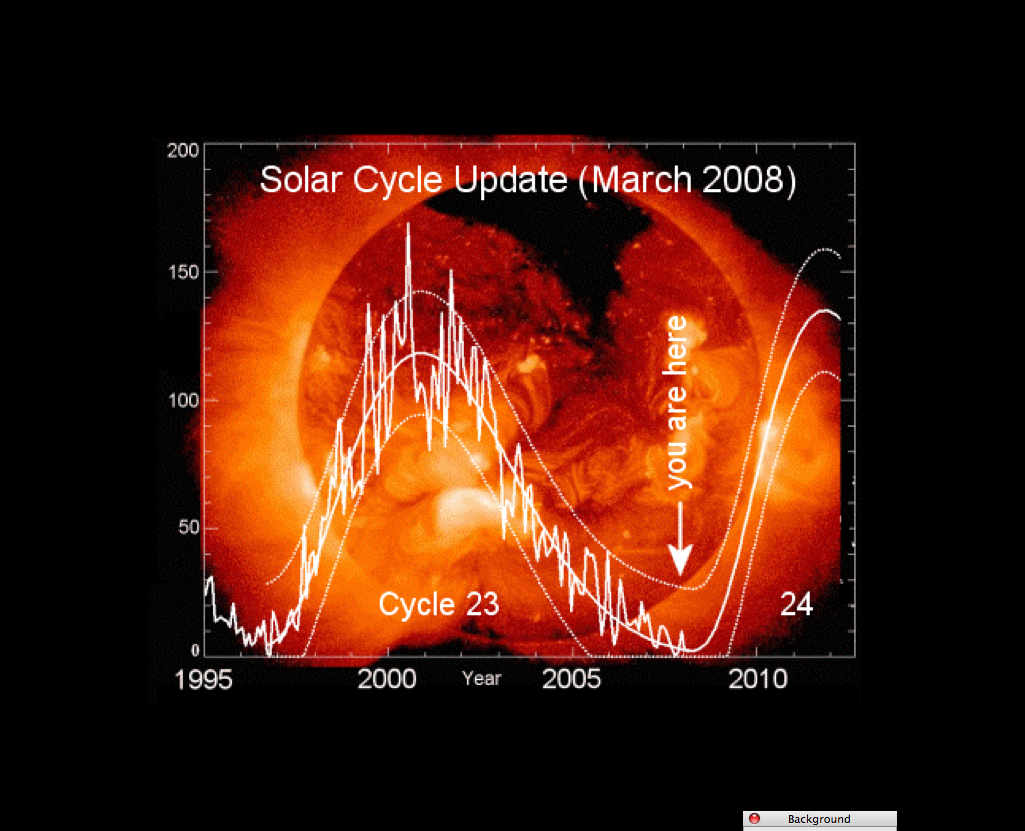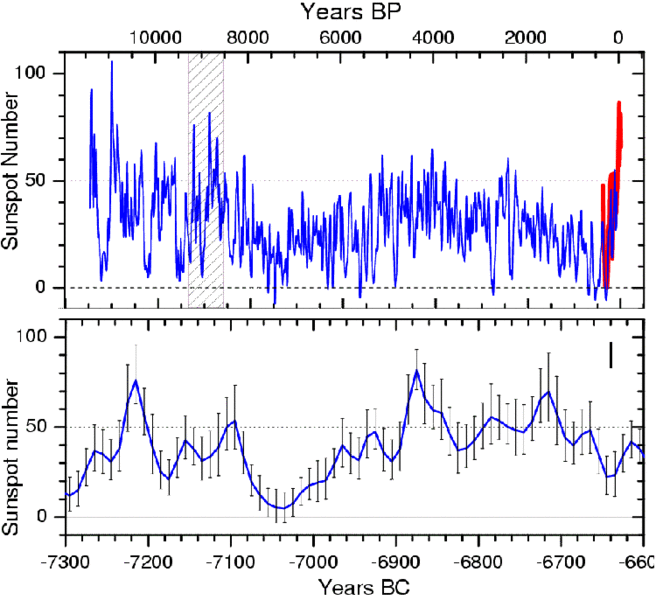It’s the Sun!
This is a common myth. It sounds sort of logical if you don’t understand the contexts involved. The fact is that we receive most of our heat energy from the sun and a little bit from the heat stored in the earths core. But does that mean this global warming event is caused by the sun? No. Here’s why:
The Solar Cycle
Sunspots
Sunspots have been observed since the time of Galileo. Since the Schwabe sunspot cycles average 11.1 years, we have limited data to see long term solar cycles clearly. But the short term Schwabe cycles are quite clear in the sunspot record.
These cycles range from 9 to 14 years in length, with an average length of 11.1 years. As of early 2009 we are experiencing an extended solar minimum, similar to the one noted around 1913. We are entering Solar Cycle 24 and you can monitor the entry to the new solar cycle with the links below.
- https://www.solarham.net
- https://solarcycle24.com/
- https://sohowww.nascom.nasa.gov/data/realtime-images.html
The solar variance between solar maximum and solar minimum accounts of a change in total solar irradiance of around 0.2 W/m2. The current forcing above natural cycle is 1.6W/m2, all major forcings considered. This clearly illustrates that our current global warming event can not be attributed to solar forcing from the sunspot cycle.
There is also a slight irradiance increase in solar output that has been noticed by NASA, but that also does not provide nearly enough forcing to account for current forcing above natural cycle. The only attribution possible is industrial greenhouse gases which are easily calculated quantitatively and the amount of forcing this provides in the system matches the amount of climate forcing we are observing.
Solar Influence
The National Academy of Sciences
National Research Council, Board on Atmospheric Science and Climate
From the NAS movie Climate Change: Lines of Evidence:
The 300/400 Year Cycle Myth?
This is an odd myth. We have good information on sunspot cycles since Galilleo’s time confirming the Schwabe cycle. In order to see a 300 year, or 400 year cycle, we would need to have good data showing the cycle for at least (at minimum) between 600 to 800 years; and ideally such data should go out into thousands of years?
But this data does not exist. So where does the 300/400 year solar cycle myth come from? Since it does not exist in the science, it must have come from opinion and conjecture. We simply don’t have enough data to see if a 300 or 400 year cycle exists. The idea that there is one, is at best a guess based on opinion. It may come from information taken out of context but there is no scientific foundation to the claim.
Source: Max Planck Society
Top: Reconstructed sunspot activity (10 year average) for the last 11,400 years based on C-14 data (blue curve) and the directly observed historical sunspot data since 1610 (red curve). The reliable C-14 data ends around the year 1900 so that the sharp increase in sunspot activity in the 20th century does not appear in the graph. The reconstruction shows clearly that a comparable period of high sunspot activity previously existed over 8000 years ago. Below: An enlarged section of the upper graph (hatched area) with several episodes of higher sun activity; comparable to the 20th century.
The above graph indicates no 300 or 400 year solar cycle. Researchers at the Max Planck Society have shown that the Sun can be responsible for, at most, only a small part of the warming over the last 20-30 years.
Source: Max Planck Society
The Solar Minimum Myth
The idea that we are going back into an extended solar minimum has several problems in the context of impact on human caused global warming.
- Since we are currently reasonably estimated at a positive forcing of 1.6 W/m2 at solar minimum in the Schwabe cycle and therefore around 1.8 W/m2 at solar maximum; and being that solar minimum can only remove around 0.2 W/m2 on the planets surface.
- The scientific body of knowledge is insufficient to establish predictability of a solar minimum.
An extended solar minimum would not stop global warming or send us into an ice age but merely slow the global warming a little bit. I should think we would all like there to be a solar minimum. However, we can not predict such a minimum at this time.
Links
- https://solarcycle24.com/
- https://sohowww.nascom.nasa.gov/data/realtime-images.html
- https://earthobservatory.nasa.gov/Features/SolarMax/
- Current View of the Sun: https://sohowww.nascom.nasa.gov/data/realtime-images.html
- Current Solar Trends: https://solarcycle24.com/
- https://www.hao.ucar.edu/Public/education/bios/schwabe.html
- https://earthobservatory.nasa.gov/Features/SolarMax/solarmax.php
- https://earthobservatory.nasa.gov/Features/SolarMax/solarmax_2.php
- https://istp.gsfc.nasa.gov/Education/whsun.html
Solar forcing – RealClimate:
- Recent Warming But No Trend in Galactic Cosmic Rays
- A critique on Veizer’s Celestial Climate Driver
- The lure of solar forcing
- Did the Sun hit record highs over the last few decades?
- Another study on solar influence
- The trouble with sunspots
- How not to attribute climate change
- Taking Cosmic Rays for a spin
- Nigel Calder in the Times
- ‘Cosmoclimatology’ – tired old arguments in new clothes (
 ) (
) ( )
) - Cosmic rays don’t die so easily
- Related content
- Solar
- Solar Conditions
Document Actions


